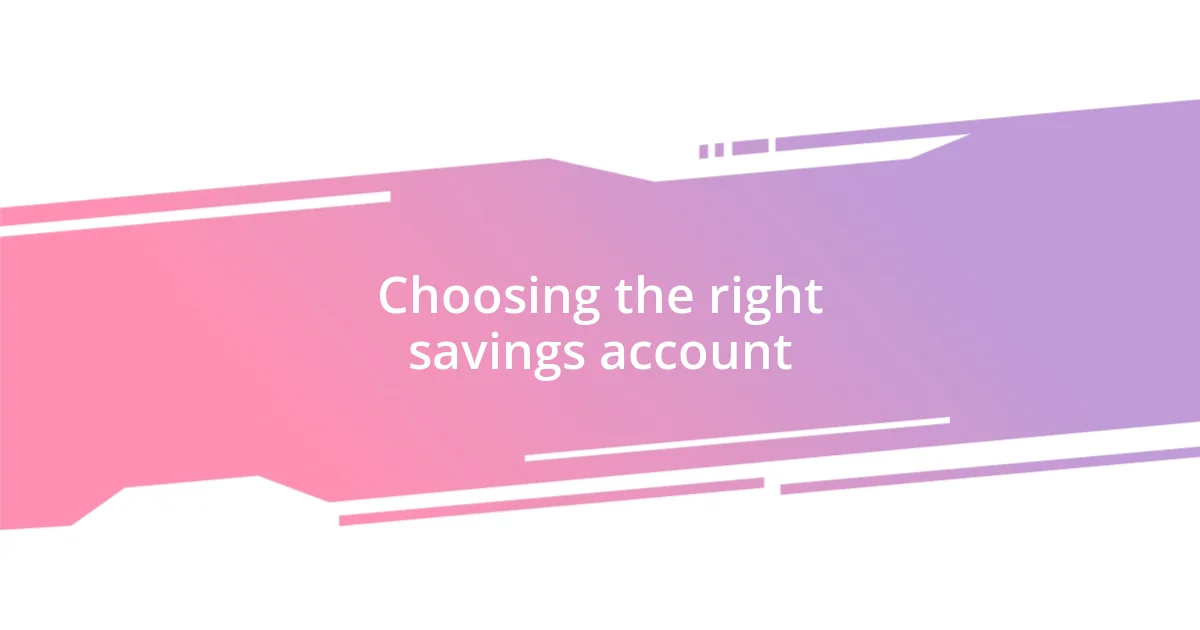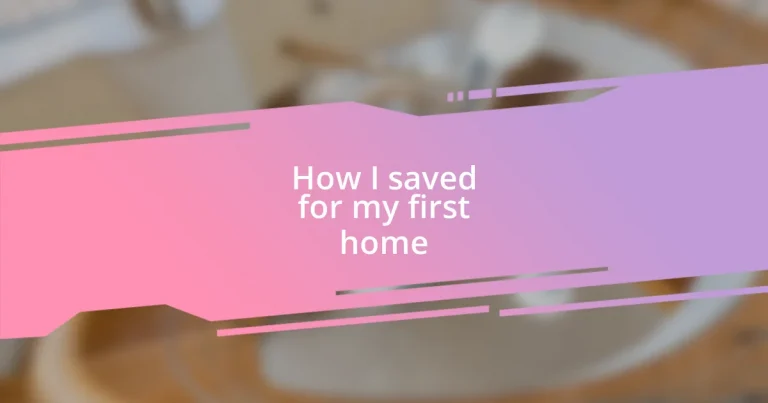Key takeaways:
- Creating a detailed budget and setting flexible savings goals were essential steps that empowered the home-buying journey.
- Choosing the right savings account and automating the savings process helped maximize growth and reduce the temptation to spend.
- Reducing unnecessary expenses and leveraging additional income sources significantly boosted savings toward homeownership.

Setting a clear budget plan
Setting a clear budget plan was crucial for me in my home-buying journey. I recall sitting down one afternoon, coffee in hand, and really taking the time to map out all my income and expenses. It was eye-opening to see where my money was going and how much I could realistically set aside for a down payment.
Creating that budget wasn’t just about numbers; it was also about dreams. I remember feeling a wave of excitement wash over me as I set savings goals, thinking about how each dollar was a step closer to my new front door. Have you ever felt that thrill in your gut when you believe you’re on the verge of achieving something significant?
I also learned the importance of being flexible. Life can throw curveballs that unsettle the best-laid plans. I adapted my budget over time, adjusting for unexpected expenses, and sometimes it meant prioritizing wants over needs. With each shift, though, I felt I was gaining more control—doesn’t that sense of empowerment feel incredible?

Understanding your savings goals
Understanding your savings goals goes beyond simply putting money aside; it’s about envisioning the life you want to lead. I distinctly remember staring at a vision board I’d created, filled with images of cozy living rooms and beautiful backyards. Each picture sparked a daydream that fueled my motivation to save. It wasn’t just about the house—it was the life I wanted within those walls. This perspective transformed my savings strategy into something deeply personal.
To clarify your savings goals, consider these key points:
– Define what type of home you want. Is it a cozy apartment or a spacious house?
– Set a specific down payment target based on market research.
– Determine the timeline for purchasing your home. When do you ideally want to move in?
– Evaluate your current financial situation to see how much you can commit monthly.
– Reflect on what sacrifices you’re willing to make to reach your goals. For instance, will you cut back on dining out or delay a vacation?
Understanding these aspects of your savings goals empowers you to create a realistic and motivating plan. As I navigated this journey, every adjustment I made reinforced my commitment and brought me closer to my dreams.

Choosing the right savings account
Choosing the right savings account is a pivotal step in your home-buying journey. I learned through experience that not all savings accounts are created equal. For instance, some accounts offer higher interest rates, while others might come with monthly fees or withdrawal restrictions. When I compared different options, it was like unraveling a mystery; the right account could make my money grow faster, pushing me closer to that front door I dreamt of.
In my search, I also realized how crucial it is to consider your savings timeline. If you’re looking at a short-term goal, like a down payment in one to three years, a high-yield savings account might be ideal. These accounts often offer better interest than traditional accounts without locking in your money. However, for longer timelines, exploring certificates of deposit (CDs) could be worthwhile—and yes, I admit, I was initially apprehensive about the limits on access, but the allure of higher returns was undeniable.
Ultimately, I cherry-picked features that aligned with my goals. Was I okay with limited access to the funds for better interest, or did I prefer the flexibility of frequent withdrawals? There’s a sense of triumph in making these decisions. I can still recall the moment I chose just the right account, feeling as though I was finally steering my ship towards homeownership.
| Account Type | Pros | Cons |
|---|---|---|
| High-Yield Savings Account | Higher interest rates, easy access | May have minimum balance requirements |
| Certificate of Deposit (CD) | Guaranteed returns, often higher than savings | Less flexibility, penalties for early withdrawal |
| Money Market Account | Higher interest, check-writing ability | Monthly maintenance fees possible |

Automating your savings process
Automating my savings was one of the best decisions I made during my home-buying journey. I set up automatic transfers from my checking account to my savings account right after payday. This way, I never saw that money in my checking account, which helped me avoid the temptation to spend it. Looking back, I wonder how many spontaneous dinners or unnecessary purchases I dodged simply by letting automation do its job.
Initially, I found the idea of automation a bit daunting. What if I needed that money for something urgent? However, I decided to start small by automating a modest amount each month. Gradually, I increased it as I became more comfortable. Each successful transfer felt like another step towards that dream home. The thrill of watching my savings grow without any effort was almost addictive.
To keep motivated, I would adjust my automation every few months depending on how my financial situation evolved. Have you considered setting up an emergency fund alongside your home savings? I did, and it really took the pressure off. Knowing that I had a safety net allowed me to save for my home with peace of mind, making the process feel both secure and exciting.

Reducing unnecessary expenses
Reducing unnecessary expenses was a game changer for me on my journey to homeownership. I made a thorough inventory of my monthly spending, and it was eye-opening to discover how many subscriptions I was hanging onto without even using. Canceling those unused memberships—like the gym pass to a place I never set foot in—freed up funds for my savings plan. Have you ever looked at your expenses and felt a light bulb moment? Trust me, it’s a refreshing experience!
I also found that dining out often drained my budget more than I realized. So, I committed to cooking at home more frequently. Each meal I prepared felt like a victory—it wasn’t just about saving money but also about embracing healthier habits. I even started experimenting with new recipes, turning a mundane task into an enjoyable routine. Who knew that saving for a home could ignite a passion for cooking?
The little changes added up quickly, creating space in my budget for that all-important down payment. I remember setting a weekly spending limit for entertainment and sticking to it diligently. It felt like I was channeling my inner financial guru! By keeping a close eye on my expenses, I didn’t miss out on life’s pleasures; I just prioritized them differently. I realized that small sacrifices lead to big rewards over time—what can you live without to achieve your goals?

Leveraging additional income sources
Leveraging additional income sources played a crucial role in my home-buying journey. I started taking on freelance projects during weekends, tapping into my skills for extra cash. It was surprising to see how a few extra hours of work each week led to significant contributions to my savings. Have you ever thought about what skills you could offer?
I also explored passive income streams, such as renting out a room on Airbnb. This not only provided me with a supplemental income but also connected me with fascinating people from different backgrounds. I remember one guest teaching me about a city I had never visited; those interactions made the whole experience rewarding and inspired me financially.
Utilizing my creativity, I even sold handmade items online. While it started as a fun experiment, it quickly transformed into a lucrative side gig. Seeing each sale come through was not just a financial boost; it felt like a tangible step toward my dream of homeownership. How would you feel if your hobbies turned into sources of income? It’s empowering, and it made the process of saving for my home not just manageable but enjoyable.














